GIGABYTE BRIX Pro: A First Look at the Intel i7-4770R with Iris Pro HD 5200
by Ganesh T S on January 7, 2014 8:00 PM EST
Gigabyte is targeting the BRIX Pro towards professional consumers with compute-intensive workloads. For general office use (including web browsing and light word processing work), systems such as the Core i5-based NUC we reviewed last week are more than enough. In order to bring out scenarios where the extra grunt provided by the Pro unit becomes necessary, we are presenting some real world benchmarks below. These are tasks carried out by workers where time in money, and the premium paid upfront for the better configuration is trivial compared to the time saved.
WinRAR Benchmark
We present two benchmarks using WinRAR. The first one involves decompressing a 4.36 GB split archive and recording the time taken to complete the process. This is a test of the CPU power as well as the storage subsystem.
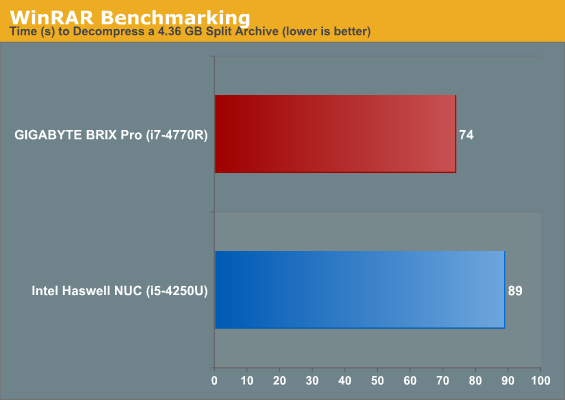
The graph below presents the internal WinRAR benchmark numbers. In this benchmark, the program takes compresses / decompresses random data in the RAM. This is a test of the CPU power as well as the DRAM capabilities.
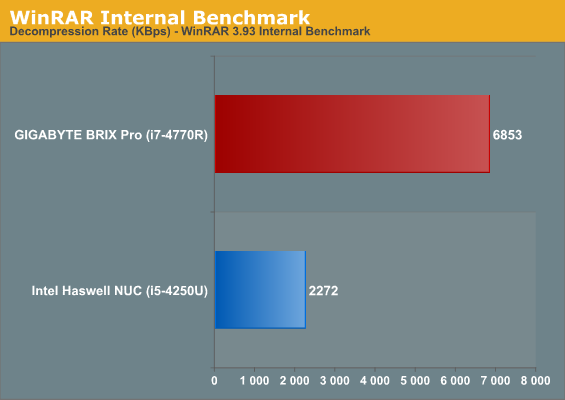
TrueCrypt Benchmark
As businesses (and even home consumers) become more security conscious, the importance of encryption can't be overstated. CPUs supporting the AES-NI instruction for accelerating the encryption and decryption processes have, till now, been the higher end SKUs. However, with Bay Trail, even the lowly Atom series has gained support for AES-NI. Both the i5-4250U and the i7-4770R have AES-NI instructions support. The TrueCrypt internal benchmark provides some interesting cryptography-related numbers to ponder. In the graph below, we can get an idea of how fast a TrueCrypt volume would behave in the two different systems.
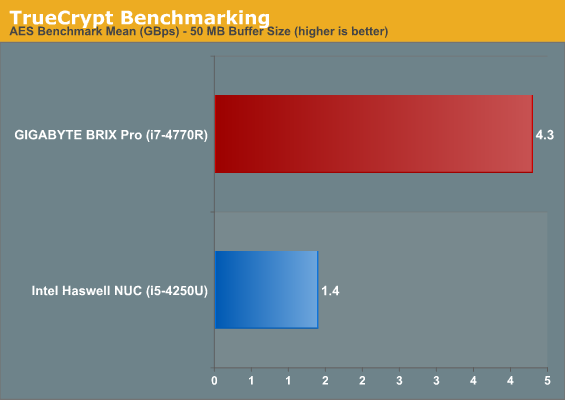
Agisoft PhotoScan
Agisoft PhotoScan is a commercial program that converts 2D images into 3D point maps, meshes and textures. The program designers sent us a command line version in order to evaluate the efficiency of various systems that go under our review scanner. The command line version has two benchmark modes, one using the CPU and the other using both the CPU and GPU (via OpenCL). The benchmark takes around 50 photographs and does four stages of computation:
Stage 1: Align Photographs
Stage 2: Build Point Cloud (capable of OpenCL acceleration)
Stage 3: Build Mesh
Stage 4: Build Textures
We record the time taken for each stage. Since various elements of the software are single threaded, others multithreaded, and some use GPUs, it is interesting to record the effects of CPU generations, speeds, number of cores, DRAM parameters and the GPU using this software.
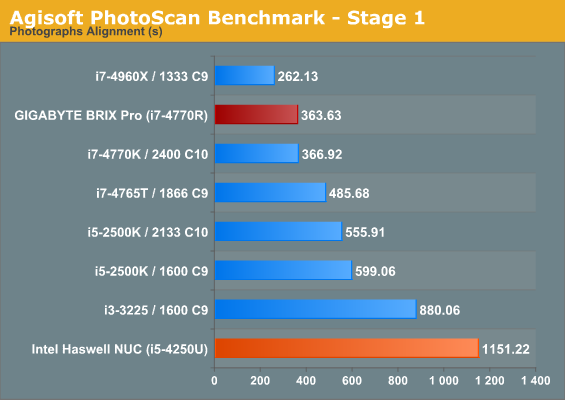
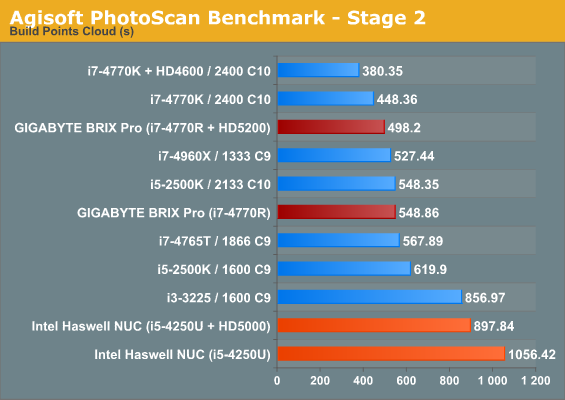

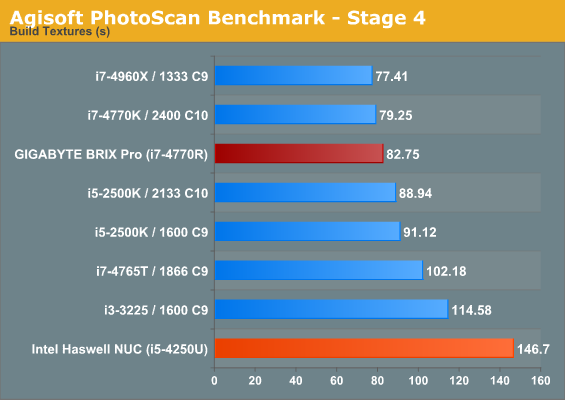
The second stage also reports the throughput rate of the CPU and GPU in million points per second. For the BRIX Pro, in the CPU only mode, we had a rate of 124.99 mp/s. Using OpenCL acceleration, the CPU and GPU had rates of 69.5 mp/s and 98.32 mp/s respectively. The corresponding numbers for the NUC were 68.36 mp/s, 20.39 mp/s and 78.59 mp/s.
Essentially a prosumer real-world test, we hope to put more of our systems under this benchmark in the future. Ian already has a large number of custom-built systems for which he will present benchmarks in his motherboard reviews.










98 Comments
View All Comments
laif - Tuesday, January 7, 2014 - link
This please. Also, please specify the kernel and graphics stack versions. Thank you.patterson32 - Tuesday, January 7, 2014 - link
Please add LZMA2 compression/decompression tests to your benchmarks. Maybe use Pixz ( https://github.com/vasi/pixz ) for both parallel compression and decompression. I tar.xz often so this would be useful for me. I don't remember the last time I used RAR.Subyman - Tuesday, January 7, 2014 - link
Strange they would call it the BRIX.JDG1980 - Tuesday, January 7, 2014 - link
The fan noise is extremely disappointing, since it pretty much rules out using the Brix Pro as a HTPC. I had hoped, especially given the price point, that this system would be fanless.DIYEyal - Tuesday, January 7, 2014 - link
a 65W TDP part in that size to be fanless?! I don't think so.. I bet you can swap the fan to some aftermarket fan, like a noctua for example (not sure if it's possible without a modding).Also, gigabyte are the first to use the 4770R and the 4570R, but I bet other OEMs go on board..
JDG1980 - Tuesday, January 7, 2014 - link
65W fanless in a small case is doable if you design the entire case as a heat sink, with heat pipes attached to the CPU core. This has been done before.Qwertilot - Wednesday, January 8, 2014 - link
There's a smallish streamcon one for ~100 pounds even. I'd rather that (and being able to use standard SSD's) than truly tiny and noisy, but I guess it wouldn't fit the theme :)Although this chip does seem like it might be pushing the limits of what works. Give it a couple more generations of intel ramping up power efficiency and we might really be talking.
MrSpadge - Tuesday, January 7, 2014 - link
Does this system have a regular Gigabyte BIOS/UEFI with options? If so try to lower the iGPU voltage: about -0.1 V should be possible at ~1.25 GHz from what I've seen from Ivy. The CPU could probably also take some tweaking. This should help noise and drive performance up. I'd be curious how far this could push such a thermally & power constrained system.Acarney - Tuesday, January 7, 2014 - link
I REALLY hope we get a detailed gaming test with this running the fastest ram possible. I thought a decent sized issue with the previous Iris Pro test was that the CPU was a good bit slower then all the recent desktop graphic card reviews AND that the TDP limit of the mobile chip might have been limiting Iris Pro some... Also very curious for a proper HTPC review of this, especially the hardest we can push MadVR with it... Yes people are moaning about fan noise but it's NOT impossible to cool a 65w TDP chip via passive means & I'm sure HDPlex or someone else will retrofit their case to accept the guts of a Brix Pro for passive cooling... Then that chip is a monster!edbless - Tuesday, January 7, 2014 - link
Intel has made this difficult for system builders.In reality the i7 4850HQ may be a better CPU option.
It is still Iris 5200, it is 47W, same form factor/mounting, and it does not cost much more.
I agree with many of the comments, if this is noisy it looses almost all value. It must in unobtrusive in all aspects, size and volume in order to fit in to most environments.